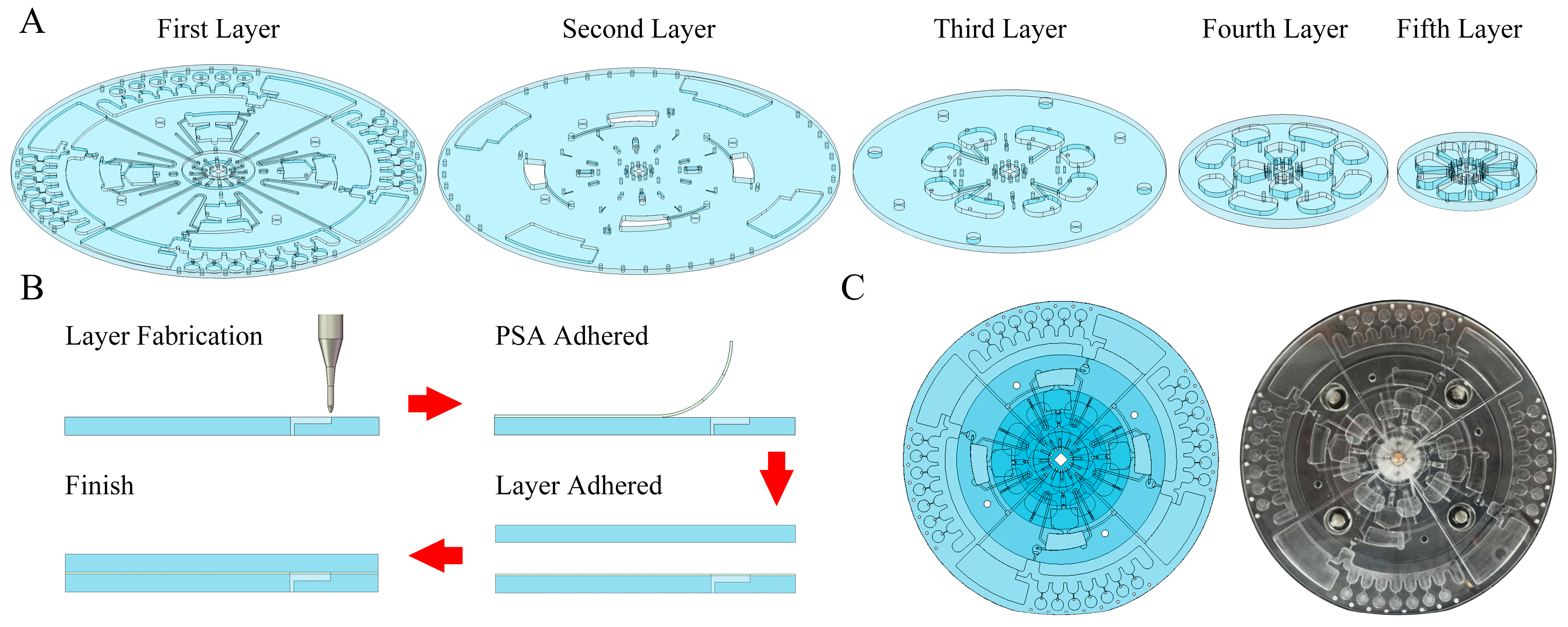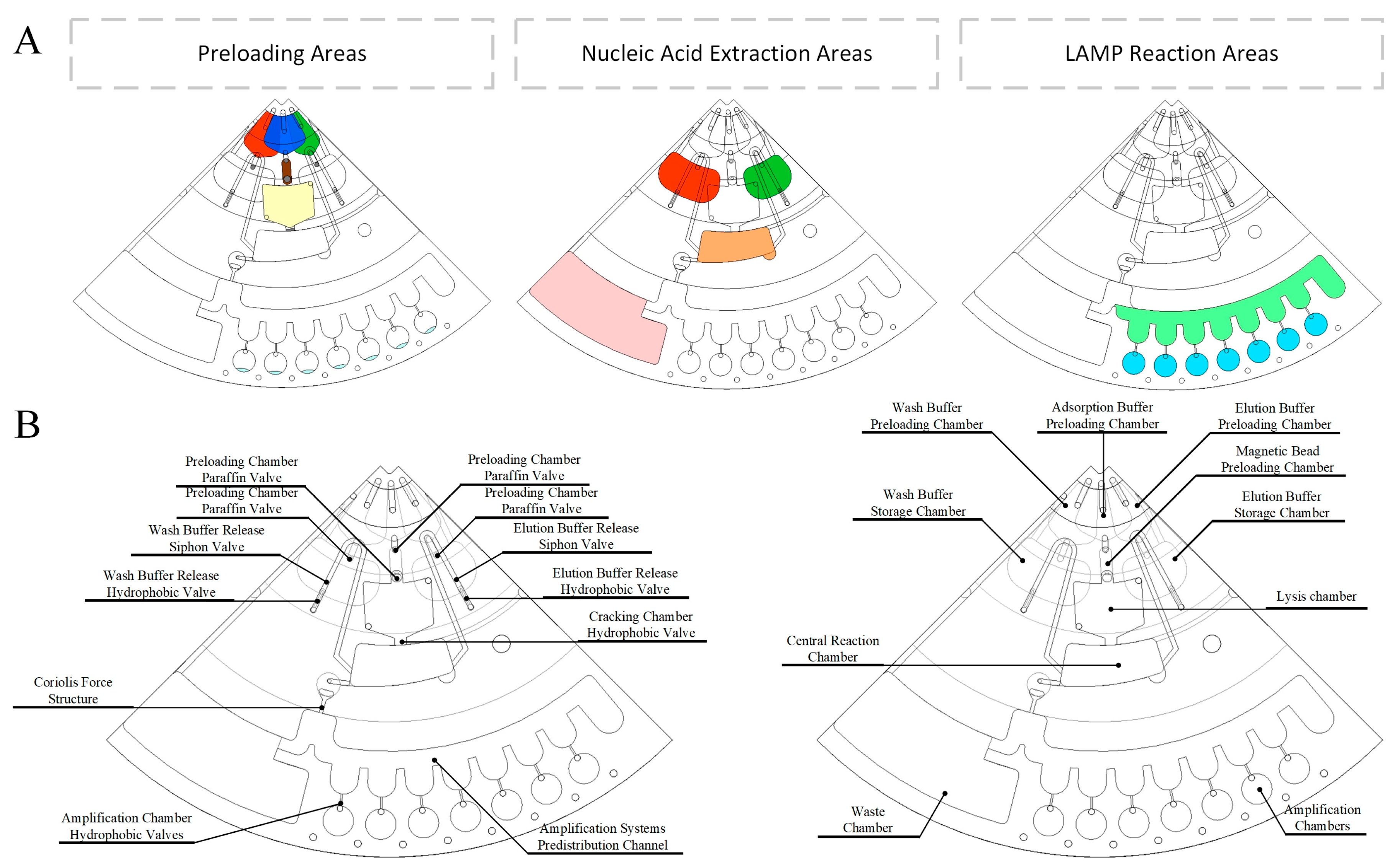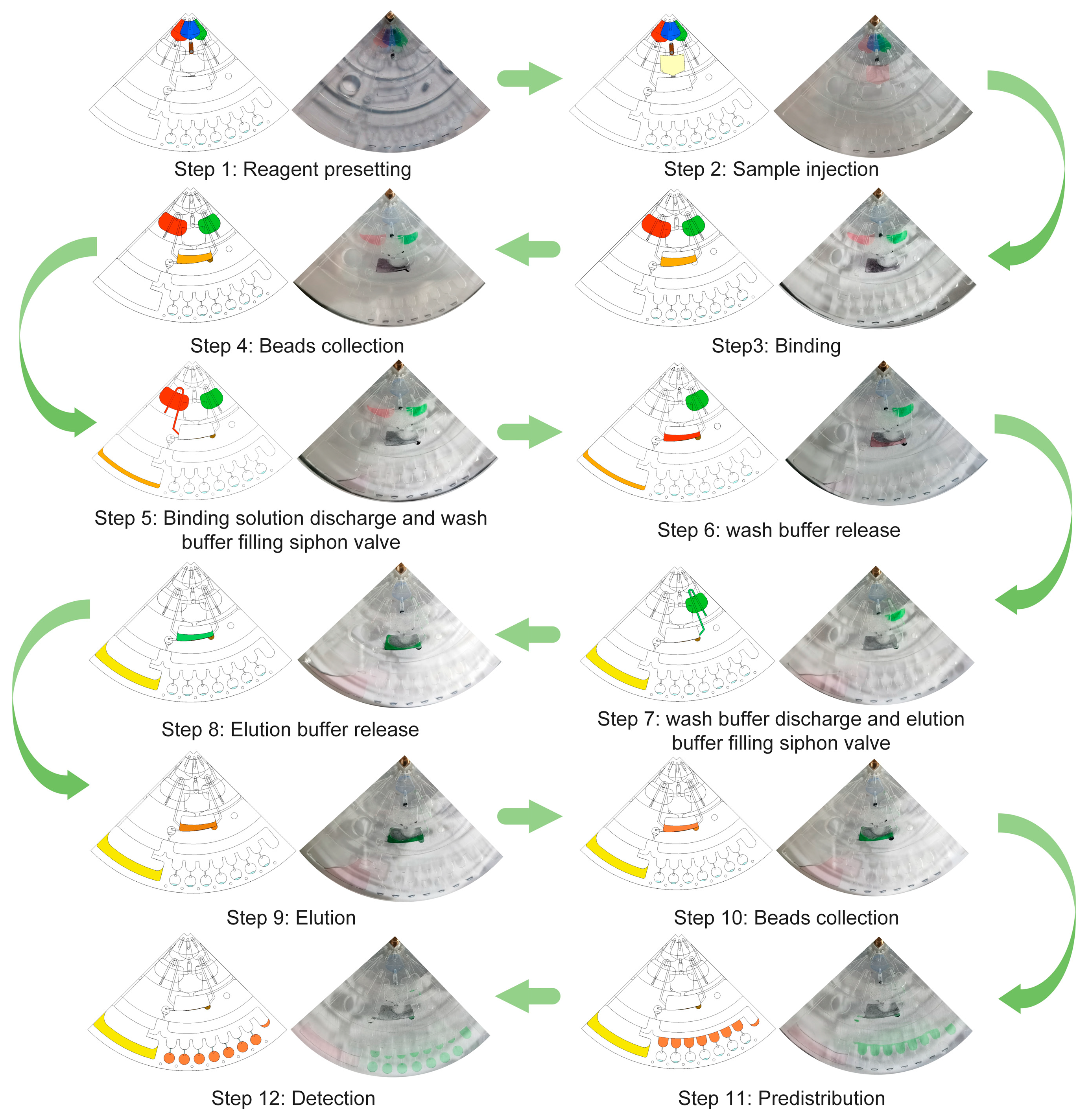Integrated High-Throughput Centrifugal Microfluidic Chip Device for Pathogen Detection On-Site
Abstract
1. Introduction
2. Materials and Methods
2.1. Fabrication of Centrifugal Microfluidic Chips
2.2. Development and Assessment of Automated Devices
2.3. Nucleic Acid Extraction and LAMP Reaction Program
2.4. Reagent Preloading
2.5. Assessment Procedures of Detection
3. Results
3.1. Design and Process of Centrifugal Microfluidic Chips
3.2. Flow Control of the Centrifugal Microfluidic Chip
3.3. Performance of Automation Integration Devices
3.4. Evaluation of Nucleic Acid Extraction and LAMP Reaction Systems
4. Discussion
5. Conclusions
Supplementary Materials
Author Contributions
Funding
Institutional Review Board Statement
Informed Consent Statement
Data Availability Statement
Conflicts of Interest
Abbreviations
References
- Xiao, Y.; Li, S.; Pang, Z.; Wan, C.; Li, L.; Yuan, H.; Hong, X.; Du, W.; Feng, X.; Li, Y.; et al. Multi-reagents dispensing centrifugal microfluidics for point-of-care testing. Biosens. Bioelectron. 2022, 206, 114130. [Google Scholar] [CrossRef]
- Yin, J.; Suo, Y.; Zou, Z.; Sun, J.; Zhang, S.; Wang, B.; Xu, Y.; Darland, D.; Zhao, J.X.; Mu, Y. Integrated microfluidic systems with sample preparation and nucleic acid amplification. Lab Chip 2019, 19, 2769–2785. [Google Scholar] [CrossRef]
- Wang, J.; Jiang, H.; Pan, L.; Gu, X.; Xiao, C.; Liu, P.; Tang, Y.; Fang, J.; Li, X.; Lu, C. Rapid on-site nucleic acid testing: On-chip sample preparation, amplification, and detection, and their integration into all-in-one systems. Front. Bioeng. Biotechnol. 2023, 11, 1020430. [Google Scholar] [CrossRef]
- Wang, S.; Qi, W.; Wu, S.; Yuan, J.; Duan, H.; Li, Y.; Lin, J. An automatic centrifugal system for rapid detection of bacteria based on immunomagnetic separation and recombinase aided amplification. Lab Chip 2022, 22, 3780–3789. [Google Scholar] [CrossRef]
- Huo, X.; Wang, L.; Qi, W.; Rong, N.; Liu, Y.; Wang, S.; Duan, H.; Lin, J. A lab-on-a-disc platform based on nickel nanowire net and smartphone imaging for rapid and automatic detection of foodborne bacteria. Chin. Chem. Lett. 2022, 33, 2091–2095. [Google Scholar] [CrossRef]
- Loo, J.; Kwok, H.; Leung, C.; Wu, S.; Law, I.; Cheung, Y.; Chin, M.; Kwan, P.; Hui, M.; Kong, S.; et al. Sample-to-answer on molecular diagnosis of bacterial infection using integrated lab-on-a-disc. Biosens. Bioelectron. 2017, 93, 212–219. [Google Scholar] [CrossRef]
- Yan, H.; Zhu, Y.; Zhang, Y.; Wang, L.; Chen, J.; Lu, Y.; Xu, Y.; Xing, W. Multiplex detection of bacteria on an integrated centrifugal disk using bead-beating lysis and loop-mediated amplification. Sci. Rep. 2017, 7, 1460. [Google Scholar] [CrossRef]
- Xiao, B.; Zhao, R.; Wang, N.; Zhang, J.; Sun, X.; Chen, A. Recent advances in centrifugal microfluidic chip-based loop-mediated isothermal amplification. TrAC Trends Anal. Chem. 2023, 158, 116836. [Google Scholar] [CrossRef]
- Deng, Y.; Liu, Y.; Jiang, Z.; Wang, J.; Zhang, Q.; Qian, Y.; Yuan, Y.; Zhou, X.; Fan, G.; Li, Y. A multiplex loop-mediated isothermal amplification assay for rapid detection of Bacillus cereus and Staphylococcus aureus. Biosci. Trends 2019, 13, 510–515. [Google Scholar] [CrossRef]
- Xiong, H.; Ye, X.; Li, Y.; Wang, L.; Zhang, J.; Fang, X.; Kong, J. Rapid Differential Diagnosis of Seven Human Respiratory Coronaviruses Based on Centrifugal Microfluidic Nucleic Acid Assay. Anal. Chem. 2020, 92, 14297–14302. [Google Scholar] [CrossRef]
- Yao, Y.; Chen, X.; Zhang, X.; Liu, Q.; Zhu, J.; Zhao, W.; Liu, S.; Sui, G. Rapid Detection of Influenza Virus Subtypes Based on an Integrated Centrifugal Disc. ACS Sens. 2020, 5, 1354–1362. [Google Scholar] [CrossRef]
- Sayad, A.; Ibrahim, F.; Uddin, S.M.; Cho, J.; Madou, M.; Thong, K.L. A microdevice for rapid, monoplex and colorimetric detection of foodborne pathogens using a centrifugal microfluidic platform. Biosens. Bioelectron. 2018, 100, 96–104. [Google Scholar] [CrossRef]
- Wang, G.; Tan, J.; Tang, M.; Zhang, C.; Zhang, D.; Ji, W.; Chen, J.; Ho, H.-P.; Zhang, X. Binary centrifugal microfluidics enabling novel, digital addressable functions for valving and routing. Lab Chip 2018, 18, 1197–1206. [Google Scholar] [CrossRef]
- Ma, J.; Wu, Y.; Liu, Y.; Ji, Y.; Yang, M.; Zhu, H. Cell-sorting centrifugal microfluidic chip with a flow rectifier. Lab Chip 2021, 21, 2129–2141. [Google Scholar] [CrossRef]
- Mishra, R.; Julius, L.A.; Condon, J.; Pavelskopfa, P.; Early, P.L.; Dorrian, M.; Mrvova, K.; Henihan, G.; Mangwanya, F.; Dreo, T.; et al. Plant pathogen detection on a lab-on-a-disc using solid-phase extraction and isothermal nucleic acid amplification enabled by digital pulse-actuated dissolvable film valves. Anal. Chim. Acta 2023, 1258, 341070. [Google Scholar] [CrossRef]
- Wang, Y.; Li, Z.; Huang, X.; Ji, W.; Ning, X.; Liu, K.; Tan, J.; Yang, J.; Ho, H.-P.; Wang, G. On-board control of wax valve on active centrifugal microfluidic chip and its application for plasmid DNA extraction. Microfluid. Nanofluid. 2019, 23, 112. [Google Scholar] [CrossRef]
- Zong, N.; Gao, Y.; Chen, Y.; Luo, X.; Jiang, X. Automated Centrifugal Microfluidic Chip Integrating Pretreatment and Molecular Diagnosis for Hepatitis B Virus Genotyping from Whole Blood. Anal. Chem. 2022, 94, 5196–5203. [Google Scholar] [CrossRef]
- Turiello, R.; Dignan, L.M.; Thompson, B.; Poulter, M.; Hickey, J.; Chapman, J.; Landers, J.P. Centrifugal Microfluidic Method for Enrichment and Enzymatic Extraction of Severe Acute Respiratory Syndrome Coronavirus 2 RNA. Anal. Chem. 2022, 94, 3287–3295. [Google Scholar] [CrossRef]
- Van Nguyen, H.; Phan, V.M.; Seo, T.S. A portable centrifugal genetic analyzer for multiplex detection of feline upper respiratory tract disease pathogens. Biosens. Bioelectron. 2021, 193, 113546. [Google Scholar] [CrossRef]
- Wang, S.; Cai, G.; Duan, H.; Qi, W.; Lin, J. Automatic and multi-channel detection of bacteria on a slidable centrifugal disc based on FTA card nucleic acid extraction and recombinase aided amplification. Lab Chip 2021, 22, 80–89. [Google Scholar] [CrossRef]
- Oh, S.J.; Park, B.H.; Choi, G.; Seo, J.H.; Jung, J.H.; Choi, J.S.; Kim, D.H.; Seo, T.S. Fully automated and colorimetric foodborne pathogen detection on an integrated centrifugal microfluidic device. Lab Chip 2016, 16, 1917–1926. [Google Scholar] [CrossRef]
- Hu, F.; Li, J.; Peng, N.; Li, Z.; Zhang, Z.; Zhao, S.; Duan, M.; Tian, H.; Li, L.; Zhang, P. Rapid isolation of cfDNA from large-volume whole blood on a centrifugal microfluidic chip based on immiscible phase filtration. Analyst 2019, 144, 4162–4174. [Google Scholar] [CrossRef]
- Hatami, A.; Saadatmand, M.; Garshasbi, M. Cell-free fetal DNA (cffDNA) extraction from whole blood by using a fully automatic centrifugal microfluidic device based on displacement of magnetic silica beads. Talanta 2024, 267, 125245. [Google Scholar] [CrossRef]
- Zhao, X.; Huang, Y.; Li, X.; Yang, W.; Lv, Y.; Sun, W.; Huang, J.; Mi, S. Full integration of nucleic acid extraction and detection into a centrifugal microfluidic chip employing chitosan-modified microspheres. Talanta 2022, 250, 123711. [Google Scholar] [CrossRef]
- Sayad, A.A.; Ibrahim, F.; Uddin, S.M.; Pei, K.X.; Mohktar, M.S.; Madou, M.; Thong, K.L. A microfluidic lab-on-a-disc integrated loop mediated isothermal amplification for foodborne pathogen detection. Sens. Actuators B-Chem. 2016, 227, 600–609. [Google Scholar] [CrossRef]
- Chen, J.; Xu, Y.; Yan, H.; Zhu, Y.; Wang, L.; Zhang, Y.; Lu, Y.; Xing, W. Sensitive and rapid detection of pathogenic bacteria from urine samples using multiplex recombinase polymerase amplification. Lab Chip 2018, 18, 2441–2452. [Google Scholar] [CrossRef]
- Xiao, Y.; Zhou, M.; Liu, C.; Gao, S.; Wan, C.; Li, S.; Dai, C.; Du, W.; Feng, X.; Li, Y.; et al. Fully integrated and automated centrifugal microfluidic chip for point-of-care multiplexed molecular diagnostics. Biosens. Bioelectron. 2024, 255, 116240. [Google Scholar] [CrossRef]
- Dignan, L.M.; Woolf, M.S.; Tomley, C.J.; Nauman, A.Q.; Landers, J.P. Multiplexed Centrifugal Microfluidic System for Dynamic Solid-Phase Purification of Polynucleic Acids Direct from Buccal Swabs. Anal. Chem. 2021, 93, 7300–7309. [Google Scholar] [CrossRef]






| Sample to Answer | Nucleic Acid Extraction Material | Bead Mixing (if Bead Was Used) | Valve | Maximum Rotational Speed | Time | Number of Sample Channel/Detection Chamber of a Channel | LOD | Ref. |
|---|---|---|---|---|---|---|---|---|
| Yes | Magnetic beads | Yes | Paraffin valves, hydrophobic valves, siphon valves, Coriolis force structure | 1500 rpm | 1 h | 4/7 | E. coli: 102 CFU/mL | This study |
| Yes | No nucleic acid extraction | - | Hydrophobic valves, capillary valves, siphon valves | 3000 rpm | 40 min | 2/10 | E. coli: 102 CFU/mL S. aureus, P. mirabilis, P. aeruginosa: 102 CFU/mL S. typhimurium: 103 CFU/mL | [26] |
| Yes | FTA | - | Silicone oil layer, check valves | 3000 rpm | 1 h | 8/1 | S. typhimurium: 10 CFU/mL | [20] |
| Yes | No nucleic acid extraction | - | Pneumatic valves, wax valves | 1500 rpm | 70 min | 4/4 | Salmonella: 5 × 10−3 ng/μL | [25] |
| Yes | Silicone membrane | - | Pneumatic siphon valves, capillary valves, Coriolis force structure | 2500 rpm | 1 h | 2/4 | 25 Escherichia or 40 Salmonella | [27] |
| No | Magnetic beads | Yes | Laser valves | 3000 rpm | 30 min | 8 | Only SARS-CoV-2 RNA extraction | [28] |
| Yes | Magnetic beads | No | Siphon valves, ball valve (magnet attracted), capillary valves, Coriolis force structure | 3600 rpm | 1 h | 2/8 | - | [17] |
| Yes | GF/F | - | Siphon valves, capillary valves, Coriolis force structure | 5000 rpm | 1.5 h | 2/9 | LAMP MPF, BDB, CDF: 103 copies/μL FHV: 104 copies/μL PCR FHV, MPF, CDF: 103 copies/μL BDB: 103 copies/μL | [19] |
| Yes | Magnetic beads | Yes | Capillary valves | 3000 rpm | ~50 min | 5/8 | - | [24] |
Disclaimer/Publisher’s Note: The statements, opinions and data contained in all publications are solely those of the individual author(s) and contributor(s) and not of MDPI and/or the editor(s). MDPI and/or the editor(s) disclaim responsibility for any injury to people or property resulting from any ideas, methods, instructions or products referred to in the content. |
© 2024 by the authors. Licensee MDPI, Basel, Switzerland. This article is an open access article distributed under the terms and conditions of the Creative Commons Attribution (CC BY) license (https://creativecommons.org/licenses/by/4.0/).
Share and Cite
Lu, S.; Yang, Y.; Cui, S.; Li, A.; Qian, C.; Li, X. Integrated High-Throughput Centrifugal Microfluidic Chip Device for Pathogen Detection On-Site. Biosensors 2024, 14, 313. https://doi.org/10.3390/bios14060313
Lu S, Yang Y, Cui S, Li A, Qian C, Li X. Integrated High-Throughput Centrifugal Microfluidic Chip Device for Pathogen Detection On-Site. Biosensors. 2024; 14(6):313. https://doi.org/10.3390/bios14060313
Chicago/Turabian StyleLu, Shuyu, Yuanzhan Yang, Siqi Cui, Anyi Li, Cheng Qian, and Xiaoqiong Li. 2024. "Integrated High-Throughput Centrifugal Microfluidic Chip Device for Pathogen Detection On-Site" Biosensors 14, no. 6: 313. https://doi.org/10.3390/bios14060313
APA StyleLu, S., Yang, Y., Cui, S., Li, A., Qian, C., & Li, X. (2024). Integrated High-Throughput Centrifugal Microfluidic Chip Device for Pathogen Detection On-Site. Biosensors, 14(6), 313. https://doi.org/10.3390/bios14060313




